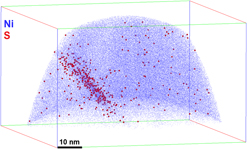Article contents
Crack propagation and mechanical properties of electrodeposited nickel with bimodal microstructures in the nanocrystalline and ultrafine grained regime
Published online by Cambridge University Press: 26 September 2017
Abstract

The article focuses on the fatigue performance after a moderate heat treatment of nanocrystalline (nc) nickel, which leads to the formation of a bimodal microstructure in the nc to ultrafine grained (ufg) regime. Electrodeposition was used to produce nc macro nickel samples with grain sizes of about 40 nm for mechanical testing. The thermal stability of the material as well as the influence on the mechanical properties and the fatigue crack propagation behavior was investigated. The results of tensile and fatigue tests are discussed in respect to the chosen production method and boundary conditions. In this context, the influence of the bath additives used during the plating process was investigated and rated as the major challenge for a further improvement of the thermal stability and mechanical properties of the material. Finally, a co-deposition of nickel and metal oxides with enhanced thermal stability is presented.
- Type
- Articles
- Information
- Journal of Materials Research , Volume 32 , Issue 24: Focus Issue: Mechanical Properties and Microstructure of Advanced Metallic Alloys—in Honor of Prof. Haël Mughrabi PART B , 28 December 2017 , pp. 4573 - 4582
- Copyright
- Copyright © Materials Research Society 2017
Footnotes
Contributing Editor: Mathias Göken
References
REFERENCES
- 11
- Cited by



